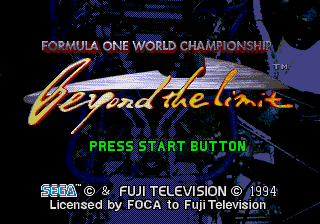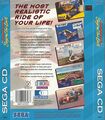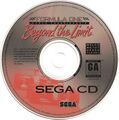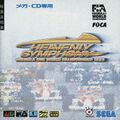Formula One World Championship: Beyond the Limit
From Sega Retro
| Formula One World Championship: Beyond the Limit (US/EU), Heavenly Symphony (JP) |
|---|
| System(s): Sega Mega CD |
| Publisher: Sega |
| Developer: Fuji Television |
| Genre: Racing |
Formula One World Championship: Beyond the Limit is a racing game for the Sega Mega CD, otherwise known as Heavenly Symphony in Japan, named as such as the individual engines that were recorded for the cars put the developers in awe and thought it sounded like a symphony. This is also one of the first racing games that uses seperate recorded engine sounds from each car, which would become standard practise in the future. It is also based off the 1993 Formula One World Championship, complete with appropriate licensing from FOCA, using each individual driver and car, with the exception of Ayrton Senna. Instead, his name and car number can be defined by the player.
Gameplay
The game takes place in a first person view from the cockpit, like many racing games on the early era consoles, but instead of using pre-defined road pieces or background deformation, this game makes use of the Sega Mega CD's extra hardware and uses scaling and rotation of an image, similar to the Super Nintendo's Mode 7. This effect is also used in Sonic CD's Special Stages and various other games.
All 16 tracks are available from the 1993 season, including the fictional Sega Park, given the location of Japan. The tracks themselves are accurate recreations of the real tracks, with appropriate elements from their real-life counter-part. For example, Donington Park, which was sponsored by SEGA, had various SEGA logos littered all over the place (with various billboards of Sonic the Hedgehog).
Modes
Like most racing games, this features a main Grand Prix mode, where you take the reins and take the 1993 season on. You will start off on the Sega Park test track, in a very generic car. From your performance, you will be able to select a team to drive for and make your contract. Based on how the player does during the season, they can either get new contract offers, or get fired from their current team. There are 4 save files to use for this mode, the player can do the season as various teams, or to be allowed for a friend's save.
There is also a 1993 Mode, allowing the player to take on challenges based off events in the 1993 season. For example, for the European Grand Prix, the player must take the role of Rubens Barrichello for 6 laps on Donington Park. The rain is at play and drivers are constantly pitting in with the changing weather. Rubens' tires are wearing out, and the player must pit, retain position, and don't let the Williams driver, Damon Hill, overtake Rubens. Upon selecting a scenario, a FMV will play showcasing a bit of the race's events, then transition into the gameplay. There are also another 4 saves for this mode.
Finally, there is a Free Run mode, where the player can drive on any track, with any amount of laps, any car of their choice, and the choice of weather.
Tobacco Sponsoring
This game controversially uses Tobacco Sponsoring. While it was standard practise for other racing games to avoid this, it would seem to be complete ignorance by the Japanese developers, despite being under supervision of FOCA and Fuji Television. Various sponsors, while visible in the cutscenes, are visible on cars and the track - Player's LTEE, for example, on the Canadian Grand Prix, and Camel on the Benneton.
Localisation Changes
In addition to the name change, various other changes were made for the American and European release. These include;
- The game was made notably more easy for the localised release. The Japanese release, for example, is slower, and engine failure is a much higher possibility. Additionally, use of the boost for longer than one lap would cause an engine failure, in accordance to one of the texts in the game. Instead, it would take around 4 laps in the exported version.
- The heads-up-display was moved to the bottom of the screen in the localised release, whereas it was on the top in Japan.
- Various songs were given different usages between versions.
- In 1993 mode, the Japanese release had music playing while racing, which went unused in the exported game.
- A bonus menu could be accessed when the player won the Driver's Championship and the Constructors Championship, giving access to all the FMVs in the game. This was not in the Japanese version.







